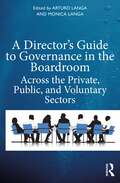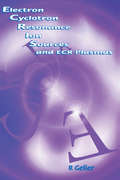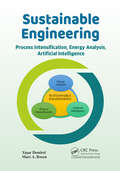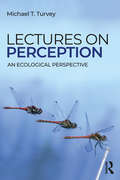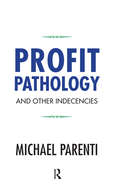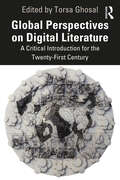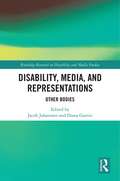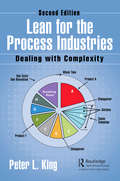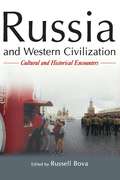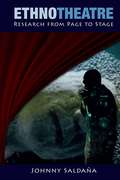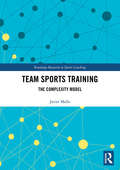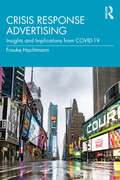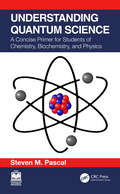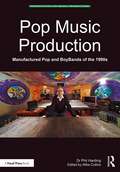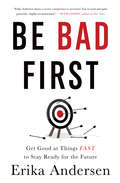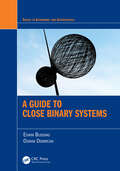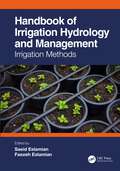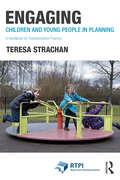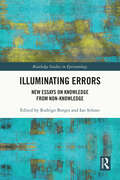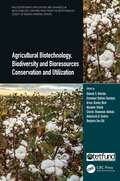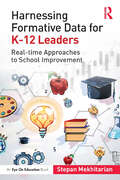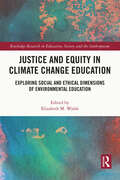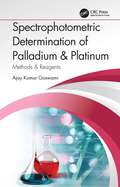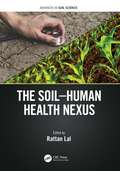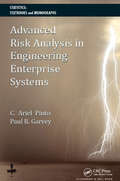- Table View
- List View
A Director's Guide to Governance in the Boardroom: Across the Private, Public, and Voluntary Sectors
by Arturo LangaThis book is a practical guide for executive and non-executive directors and aspiring directors to lead, govern, and steer UK-based organisations to long-term sustainable success. In today’s turbulent environment, corporate governance is increasingly scrutinised, and this book will consider how directors can ‘bring the future forward’ with respect to responsible and ethical governance and leadership against the challenging political, environmental, and economic backdrop. While other books discuss UK corporate governance, this one uniquely demonstrates how the work of directors can build an organisation’s antifragility, and offers a view of stewardship approaches to every sector and type of UK organisation, from large premium listed companies to start-ups, the public sector, not-for-profits, partnerships, and family-owned and private-equity-backed organisations. Aspiring and experienced directors will each benefit from this book as well as those who provide board evaluation services, professional advisers, auditors, and those who provide training and other support for board members.
Electron Cyclotron Resonance Ion Sources and ECR Plasmas
by R GellerAcknowledged as the "founding father" of and world renowned expert on electron cyclotron resonance sources Richard Geller has produced a unique book devoted to the physics and technicalities of electron cyclotron resonance sources. Electron Cyclotron Resonance Ion Sources and ECR Plasmas provides a primer on electron cyclotron phenomena in ion sour
Sustainable Engineering: Process Intensification, Energy Analysis, and Artificial Intelligence
by Yasar Demirel Marc A. RosenSustainable engineering is of great importance for resilient and agile technology and society. This book balances economics, environment, and societal elements of sustainable engineering by integrating process intensification, energy analysis, and artificial intelligence to reduce production costs, improve the use of material and energy, product quality, safety, societal well-being, and water usage. The book provides comprehensive discussion of topics on process intensification, energy analysis, and artificial intelligence that include optimization, energy integration, green engineering, pinch analysis, exergy analysis, feasibility analysis, life cycle assessment, circular economy, bioeconomy, data processing, machine learning, expert systems, digital twins, and self-optimized plants for sustainable engineering.
Lectures on Perception: An Ecological Perspective (Resources for Ecological Psychology Series)
by Michael T. TurveyLectures on Perception: An Ecological Perspective addresses the generic principles by which each and every kind of life form—from single celled organisms (e.g., difflugia) to multi-celled organisms (e.g., primates)—perceives the circumstances of their living so that they can behave adaptively. It focuses on the fundamental ability that relates each and every organism to its surroundings, namely, the ability to perceive things in the sense of how to get about among them and what to do, or not to do, with them. The book’s core thesis breaks from the conventional interpretation of perception as a form of abduction based on innate hypotheses and acquired knowledge, and from the historical scientific focus on the perceptual abilities of animals, most especially those abilities ascribed to humankind. Specifically, it advances the thesis of perception as a matter of laws and principles at nature’s ecological scale, and gives equal theoretical consideration to the perceptual achievements of all of the classically defined ‘kingdoms’ of organisms—Archaea, Bacteria, Protoctista, Fungi, Plantae, and Animalia.
Profit Pathology and Other Indecencies
by Michael ParentiFrom market crisis to market boom, from welfare to wealth care, from homelessness to helplessness, and an all-out assault on the global environment-these are just some of the indecencies of contemporary economic life that Profit Pathology takes on. Here, Michael Parenti investigates how class power is a central force in our political life and, yet, is subjected to little critical discernment. He notes how big-moneyed interests shift the rules of the game in their favor while unveiling the long march by reactionaries through the nation's institutions to undo all the gains of social democracy, from the New Deal to the present. Parenti also traces the exploitative economic forces that have operated through much of American history, including the mass displacement and extermination of Native Americans and the enslavement of Africans. Parenti is a master at demonstrating the impact of monomaniacal profit accumulation on social services-especially health care-and human values. Here he takes us one step further, showing how unrestrained capitalism ultimately endangers itself, becoming a "self-devouring beast" that threatens us all. Finally, he calls for a solution based on democratic diversity and public ownership-"because it works."
Global Perspectives on Digital Literature: A Critical Introduction for the Twenty-First Century
by Torsa GhosalGlobal Perspectives on Digital Literature: A Critical Introduction for the Twenty-First Century explores how digital literary forms shape and are shaped by aesthetic and political exchanges happening across languages and nations. The book understands "global" as a mode of comparative thinking and argues for considering various forms of digital literature—the popular, the avant-garde, and the participatory—as realizing and producing global thought in the twenty-first century. Attending to issues of both political and aesthetic representation, the book includes a diverse group of contributors and a wide-ranging corpus of texts, composed in a variety of languages and regions, including East and South Asia, parts of Europe, Latin America, North America, Australia, and Western Africa. The book’s contributors adopt an array of interpretive approaches to make visible new connections and possibilities engendered by cross-cultural encounters. Among other topics, they reflect on the shifting conditions for production and distribution of literature, participatory cultures and technological affordances of Web 2.0, the ever-changing dynamics of global and local forces, and fundamental questions, such as, "What do we mean when we talk about literature today?" and "What is the future of literature?"
Disability, Media, and Representations: Other Bodies (Routledge Research in Disability and Media Studies)
by Jacob Johanssen Diana GarrisiBringing together scholars from around the world to research the intersection between media and disability, this edited collection aims to offer an interdisciplinary exploration and critique of print, broadcast and online representations of physical and mental impairments.Drawing on a wide range of case studies addressing how people can be ‘othered’ in contemporary media, the chapters focus on analyses of hateful discourses about disability on Reddit, news coverage of disability and education, media access of individuals with disabilities, the logic of memes and brain tumour on Twitter, celebrity and Down Syndrome on Instagram, disability in TV drama, the metaphor of disability for the nation; as well as an autoethnography of treatment of breast cancer. Providing a much-needed global perspective, Disability, Media, and Representations examines the relationship between self-representation and representations in either reinforcing or debunking myths around disability, and ways in which academic discourse can be differently articulated to study the relationship between media and disability. This book will be of interest to students and researchers of disability studies and media studies as well as activists and readers engaged in debates on diversity, inclusivity and the media.
Lean for the Process Industries: Dealing with Complexity, Second Edition
by Peter L. KingCompared to its widespread implementation across almost all areas of production, Lean improvement efforts lag within the process industries. While many innovators have successfully applied Lean principles to these industries during the past three decades, most of those pioneering efforts were never recorded to guide the improvement efforts of others.Drawing on more than 40 years of application experience at one of the world’s largest chemical and materials manufacturers, coupled with 10 years in private practice, Peter King corrects this void by providing the first comprehensive resource written explicitly for change agents within the process industries. Focusing on areas where the improvement needs of the process industry differ from parts assembly manufacturing, Lean for the Process Industries: Dealing with Complexity, Second Edition: Covers each of the eight wastes commonly described in Lean literature, looking at how they manifest themselves in process operations. Explains how to adapt value stream mapping for process operations. Shows how to identify the root causes of bottlenecks, and how to manage them to optimize flow until they can be eliminated. Provides practical techniques to overcome the barriers which have prevented the application of Cellular Manufacturing to process operations. Discusses the role of business leadership in a Lean strategy, describing both enabling and counter-productive management behaviors Since the publication of the first edition of this book, Peter King has been busy consulting with food, beverage, gasoline additive, and nutraceutical companies -- these new experiences have broadened his perspectives on certain Lean processes and have given him a richer set of examples to discuss in this new edition.While Value Stream Mapping is a very powerful tool to understand flow, bottlenecks, and waste in an operation, the traditional format as presented in many other books does not describe all of the data required to fully understand process flow and its detractors. This new edition highlights the necessary additions with examples of why they are useful.Product wheel scheduling achieves production leveling in a far more comprehensive and effective way than traditional heijunka methods. This edition has a more thorough description of the wheel concept and design steps, and more examples from actual applications.
Russia and Western Civilization: Cutural and Historical Encounters
by Russell BovaThis volume introduces readers to an age-old question that has perplexed both Russians and Westerners. Is Russia the eastern flank of Europe? Or is it really the heartland of another civilization? In exploring this question, the authors present a sweeping survey of cultural, religious, political, and economic developments in Russia, especially over the nineteenth and twentieth centuries. Based on the inter-disciplinary Russian studies program at Dickinson College, this splendid collection will complement many curricula. The text features highlight boxes and selected illustrations. Each chapter ends with a glossary, study questions, and a reading list.
Ethnotheatre: Research from Page to Stage (ISSN)
by Johnny SaldañaEthnotheatre transforms research about human experiences into a dramatic presentation for an audience. Johnny Saldaña, one of the best-known practitioners of this research tradition, outlines the key principles and practices of ethnotheatre in this clear, concise volume. He covers the preparation of a dramatic presentation from the research and writing stages to the elements of stage production. Saldaña nurtures playwrights through adaptation and stage exercises, and delves into the complex ethical questions of turning the personal into theatre. Throughout, he emphasizes the vital importance of creating good theatre as well as good research for impact on an audience and performers. The volume includes multiple scenes from contemporary ethnodramas plus two complete play scripts as exemplars of the genre.
Team Sports Training: The Complexity Model (Routledge Research in Sports Coaching #10)
by Javier MalloTeam Sports Training: The Complexity Model presents a novel approach to team sports training, examining football (soccer), rugby, field hockey, basketball, handball and futsal through the paradigm of complexity. Under a traditional prism, these sports have been analyzed using a deterministic perspective, where the constituent dimensions of the sportsmen were independently examined and treated in isolation. It was expected that the body worked as a perfect machine and, once all the components were maximized, the sportsmen improved their performance. If the same closed recipe was applied to all the players that formed part of the squad, the global team performance was expected to be enhanced.As much as these reductionistic models seem coherent, when contrasted in practice we see that the reality of team sports is far more different from the closed conditions in which they were idealized. Team sports contain variable, heterogeneous and non-linear constrains which require the development of a different logic to organize their training.During the last years, ecological psychology, the dynamical systems theory or the constraints-led approach have opened interesting fields of research from which many conceptual foundations can be applied to team sports. Based in this contemporary framework, the current book presents the study of the players and the teams as complex systems, using coordination dynamics to explain the emergence of the self-organisation episodes that characterize them. In addition, this thinking line provides the reader with the ability to apply all these innovative concepts to their practical training scenarios. Altogether, it is intended to challenge the reader to re-think their training strategy and to develop an original theory and practice of training specific to team sports.
Crisis Response Advertising: Insights and Implications from COVID-19
by Frauke HachtmannThis book examines the effects of COVID-19 on the advertising industry to better understand crisis response advertising.The book tells the story of three distinct phases in which the pandemic unfolded, the way a wide range of brands and agencies responded, and how the consumer landscape changed during the first 15 months of the crisis. Advertising professionals from a broad range of award-winning advertising agencies across the United States who experienced the crisis first-hand reflect on how COVID-19 disrupted the industry and what they learned along the way. Each case contains themes that emerged through data analysis, along with examples of advertising practice at various stages of the pandemic. Importantly, the new theoretical model and best practices covered in the book extend beyond application to the global pandemic, giving readers solid theoretical and practical tools to use in future crises.Suited for upper-level undergraduate and post-graduate courses in advertising and marketing, this book will be useful as a reference for researchers and is practical enough for practitioner use as well.
Understanding Quantum Science: A Concise Primer for Students of Chemistry, Biochemistry and Physics
by Steven M. PascalStudents are naturally drawn to quantum science by the intriguing behaviors of small particles. However, they can also be intimidated by the lengthy and complicated treatment found in the classroom. Understanding Quantum Science: A Concise Primer for Students of Chemistry, Biochemistry, and Physics is a highly accessible book that offers students an opportunity to grasp the most fascinating of quantum topics, without the intimidation. To be sure, math is necessary, but it is introduced as needed and kept concise. The emphasis is on the science: a certain differential equation can be solved, and when it is, we find the energies that hydrogen atom electrons are allowed to have. Each concept is developed in this manner, keeping focus on how and why it arises, and on the intriguing consequences.This book provides a brief tour of some of the wonders of quantum science. But it is more than that, it is designed to be the most concise tour possible that truly explains how these wonders arise so that you can develop a working understanding of quantum concepts. If your goal is loftier and you wish to become a quantum specialist, the conceptual groundwork presented here, along with rationalization of the mathematics required, will position you well for higher level classes.
Pop Music Production: Manufactured Pop and BoyBands of the 1990s (ISSN)
by Phil HardingPop Music Production delves into academic depths around the culture, the business, the songwriting, and most importantly, the pop music production process. Phil Harding balances autobiographical discussion of events and relationships with academic analysis to offer poignant points on the value of pure popular music, particularly in relation to BoyBands and how creative pop production and songwriting teams function.Included here are practical resources, such as recording studio equipment lists, producer business deal examples and a 12-step mixing technique, where Harding expands upon previously released material to explain how ‘Stay Another Day’ by East 17 changed his approach to mixing forever. However, it is important to note that Harding almost downplays his involvement in his career. At no point is he center stage; he humbly discusses his position within the greater scheme of events. Pop Music Production offers cutting-edge analysis of a genre rarely afforded academic attention.This book is aimed at lecturers and students in the subject fields of Music Production, Audio Engineering, Music Technology, Popular Songwriting Studies and Popular Music Culture. It is suitable for all levels of study from FE students through to PhD researchers. Pop Music Production is also designed as a follow-up to Harding’s first book PWL from the Factory Floor (2010, Cherry Red Books), a memoir of his time working with 1980s pop production and songwriting powerhouse, Stock Aitken Waterman, at PWL Studios.
Be Bad First: Get Good at Things Fast to Stay Ready for the Future
by Erika AndersenWe are operating in a world defined by constant connection, rapid change, and abundant choices. News that once took months, even years, to spread now reaches across the globe in seconds. Advances in medicine and science are pushing boundaries with gene therapy and stem cell transplants. And decisions about where and how to work and live are nearly endless. As new knowledge--and the possibilities that arise from that knowledge--propels us forward, leadership readiness expert and renowned author Erika Andersen suggests that success in today's world requires the ability to acquire new knowledge and skills quickly and continuously--in spite of our mixed feelings about being a novice. In her newest book, Be Bad First, Erika explores how we can become masters of mastery; proficient in the kind of high-payoff learning that's needed today. With assessments and exercises at the close of every chapter, she encourages readers to embrace being bad on the way to being great--to be novices over and over again as we seek to learn and acquire the new skills that will allow us to thrive in this fast-changing world.
A Guide to Close Binary Systems (ISSN)
by Edwin Budding Osman DemircanIntroduction to Close Binary Systems provides a comprehensive survey and guide to the fast-moving field of multiple, specifically binary, stars, with an up to date account of research around 'close', i.e. interacting pairs. Such interactions allow direct quantification of stellar properties, opening up factual insights into basic building blocks of the Universe.The book provides a much needed update for the seminal Close Binary Systems of Zdenĕk Kopal. Following a comparable plan, it presents relevant subject matter with an emphasis on building a framework of understanding to serve as a supporting resource for students and researchers. The text starts from a general historical background and progresses into the main theoretical ideas supporting our prima facie interpretation of observations. The central chapters explore further into these observational methods, arranged according to the classic subdivisions of astrometry, spectroscopy and photometry. Optimal inversion of observational data into model parametrization is a theme through these chapters. Significant here is the problem of how non-uniqueness in modelling affects interpretation. The underlying issues of stellar evolution bearing on observational evidence become paramount in the last four chapters. The book proceeds step-by-step from directly understandable examples of unevolved pairs to the challenging cases where stars are found in more and more extreme conditions, leading up to the mergers of massive black hole pairs seen in the new field of gravitational wave astronomy. This is a valuable reference for postgraduate and advanced undergraduate students working in mainstream areas of stellar astrophysics, with applications also to exoplanet research which shares some methodological features. Course designers for stellar astrophysics will find a useful selection of topics within this book.Key features:• Provides a well-explained and backgrounded, up-to-date account of close binary systems, in a fast-moving field of research that is growing in scientific importance• Surveys a wide range of case-studies within the context of binary and multiple star systems• Fills an acknowledged gap in current literatureCover Image: A public memorial to Zdenek Kopal in his home town (birthplace) of Litomysl in Czechia.
Handbook of Irrigation Hydrology and Management: Irrigation Methods
by Saeid Eslamian Faezeh EslamianEver-increasing population growth has caused a proportional increased demand for water, and existing water sources are depleting day by day. Moreover, with the impact of climate change, the rates of rainfall in many regions have experienced a higher degree of variability. In many cities, government utilities have been struggling to maintain sufficient water for the residents and other users. The Handbook of Irrigation Hydrology and Management: Irrigation Methods examines and analyzes irrigated ecosystems in which water storage, applications, or drainage volumes are artificially controlled in the landscape and the spatial domain of processes varies from micrometers to tens of kilometers, while the temporal domain spans from seconds to centuries. The continuum science of irrigation hydrology includes the surface, subsurface (unsaturated and groundwater systems), atmospheric, and plant subsystems. Further, the book addresses the best practices for various types of irrigation methods including pressure, smart, surface, and subsurface, and presents solutions for water scarcity and soil salinity in irrigation.Features: Offers water-saving strategies to increase the judicious use of scarce water resources Presents strategies to maximize agricultural yield per unit of water used for different regions Compares irrigation methods to offset changing weather patterns and impacts of climate change
Engaging Children and Young People in Planning: A Handbook for Transformative Practice (ISSN)
by Teresa StrachanEngaging Children and Young People in Planning places planners’ skills for engagement with children and young people centre stage by discussing several projects delivered or supported by planning students to young people in the Northeast of England. Urban or town and country planning is a largely unfamiliar concept to children and young people. Moreover, in England, the environment in which young people live, play and go to school is shaped by a local planning process which lacks their input. This book explores the nature of the gap between that planning process and the voice of the younger members of the community, as well as the barriers that impede this engagement. It highlights why an engagement process is beneficial for those young people, for the wider community and for the planning process itself. At a time when our relationship with and impact on, the environment is being re-examined, this book challenges the planning professional to identify, develop and reflect upon the engagement skills that will help to transform planning into a more inclusive practice. It will be of use to scholars and practitioners in urban planning, community planning, engagement and children’s rights, whilst supporting their academic and professional development pathways.
Illuminating Errors: New Essays on Knowledge from Non-Knowledge (Routledge Studies in Epistemology)
by Rodrigo Borges Ian SchneeThis is the first collection of essays exclusively devoted to knowledge from non-knowledge and related issues. It features original contributions from some of the most prominent and up-and-coming scholars working in contemporary epistemology.There is a nascent literature in epistemology about the possibility of inferential knowledge based on premises that are, for one reason or another, not known. The essays in this book explore if and how epistemology can accommodate cases where knowledge is generated from something other than knowledge. Can reasoning from false beliefs generate knowledge? Can reasoning from unjustified beliefs generate knowledge? Can reasoning from gettiered beliefs generate knowledge? Can reasoning from propositions one does not even believe generate knowledge? The contributors to this book tackle these and other questions head-on. Together, they advance the debate about knowledge from non-knowledge in novel and interesting directions. Illuminating Errors will be of interest to researchers and advanced students working in epistemology and philosophy of mind.
Agricultural Biotechnology, Biodiversity and Bioresources Conservation and Utilization (Multidisciplinary Applications and Advances in Biotechnology)
by Emmanuel Olufemi Ekundayo Arinze Stanley Okoli Abubakar Gidado Charles Oluwaseun Adetunji Abdulrazak B. Ibrahim Benjamin Ewa Ubi Olawole O. ObembeThis book covers a range of important topics on crop and animal genetics, breeding and genomics, as well as biodiversity and genetic resources conservation and utilization reflecting three thematic sections of working groups of the Biotechnology Society of Nigeria. The topics range from agricultural biotechnology, including genetically modified organisms and gene-editing for agronomically important traits in tropical crops, to Nigeria’s mega biodiversity and genetic resources conservation. This book will engender a deeper understanding of underpinning mechanisms, technologies, processes and science–policy nexus that has placed Nigeria as a leader in biotechnology in Africa. The book will be useful reference material for scientists and researchers working in the fields of food and agricultural biotechnology, bioinformatics, plant and animal genetics, breeding and genomics, genetic resources conservation and enhancement. Emphasizes recent advances in biotechnologies that could ameliorate the high-level global food and nutrition insecurity through plant and animal genetics, breeding, as well as genomics Provides detailed information towards harnessing indigenous bioresources for food and nutrition security and climate change adaptation Introduces new frontiers in the area of genomics, most especially their relevant applications in crop and animal breeding Reviews biotechniques that could enhance plant genetic resources conservation and utilization Discusses current biotechnological approaches to exploit genetic resources including the development of synthetic hexaploid wheat (SHW) for crop adaptation to the increasingly changing global climate
Harnessing Formative Data for K-12 Leaders: Real-time Approaches to School Improvement
by Stepan MekhitarianHarnessing Formative Data for K-12 Leaders prepares school and district leaders to re-evaluate how real-time formative data can inform policy, planning, and professional development. The importance of effective formative data use has escalated since the expansion of distance learning and the integration of digital education tools, which have impacted the consistency, accuracy, availability, and actionability of data points that leaders rely on. This book’s strategic insights into actionable, organizational-level formative data use will yield differentiated supports for schools to foster greater academic outcomes, a culture of equity and social-emotional well-being, and students’ readiness for college, career, and lifelong learning. Each chapter includes connections to social justice, best practices for applying data points and field-tested tips for technology integration, and a host of interactive planning guides to support implementation.
Justice and Equity in Climate Change Education: Exploring Social and Ethical Dimensions of Environmental Education (Routledge Research in Education, Society and the Anthropocene)
by Elizabeth M. WalshThis volume looks at the ways in which climate change education relates to broader ideas of justice, equity, and social transformation, and ultimately calls for a rapid response to the need for climate education reform. Highlighting the role of climate change in exacerbating existing societal injustices, this text explores the ethical and social dimensions of climate change education, including identity, agency, and societal structure, and in doing so problematizes climate change education as an equity concern. Chapters present empirical analysis, underpinned by a theoretical framework, and case studies which provide critical insights for the design of learning environments, curricula, and everyday climate change-related learning in schools. This text will benefit researchers, academics, educators, and policymakers with an interest in science education, social justice studies, and environmental sociology more broadly. Those specifically interested in climate education, curriculum studies, and climate adaption will also benefit from this book.
Spectrophotometric Determination of Palladium & Platinum: Methods & Reagents
by Ajay Kumar GoswamiThis versatile resource consolidates available methods for the spectrophotometric determination of palladium and platinum and serves as a practical ready-to-use guide for those researching palladium and platinum and for those working in the field of medicinal metal complexes of the two metals. The beauty of spectrophotometric methods lies in their simplicity, convenience, and easy operability, not to mention their cost-effectiveness. They can be automated easily and are thus the most affordable methods for the below reasons: Address analysts from all areas of industry, research labs and postgraduate students of analytical or medicinal chemistry as well as material science Detail all recently developed methods for palladium and platinum determination using spectrophotometry in a single source. Organized so that anyone interested in a particular method using a specific reagent can go directly to those details Facilitates the development of better methods for specific conditions of a sample
The Soil-Human Health-Nexus (ISSN)
by Rattan LalThe term "soil health" refers to the functionality of a soil as a living ecosystem capable of sustaining plants, animals, and humans while also improving the environment. In addition to soil health, the environment also comprises the quality of air, water, vegetation, and biota. The health of soil, plants, animals, people, and the environment is an indivisible continuum. One of the notable ramifications of the Anthropocene is the growing risks of decline in soil health by anthropogenic activities. Important among these activities are deforestation, biomass burning, excessive soil tillage, indiscriminate use of agrochemicals, excessive irrigation by flooding or inundation, and extractive farming practices. Soil pollution, by industrial effluents and urban waste adversely impacts human health. Degradation of soil health impacts nutritional quality of food, such as the uptake of heavy metals or deficit of essential micro-nutrients, and contamination by pests and pathogens. Indirectly, soil health may impact human health through contamination of water and pollution of air.This book aims to:Present relationships of soil health to human health and soil health to human nutrition. Discuss the nexus between soil degradation and malnourishment as well as the important links between soil, plant, animal and human health. Detail reasons oil is a cause of infectious diseases and source of remedial measures.Part of the Advances in Soil Sciences series, this informative volume covering various aspects of soil health appeals to soil scientists, environmental scientists and public health workers.
Advanced Risk Analysis in Engineering Enterprise Systems (Statistics: A Series of Textbooks and Monographs)
by Cesar Ariel Pinto Paul R. GarveySince the emerging discipline of engineering enterprise systems extends traditional systems engineering to develop webs of systems and systems-of-systems, the engineering management and management science communities need new approaches for analyzing and managing risk in engineering enterprise systems. Advanced Risk Analysis in Engineering Enterpri
